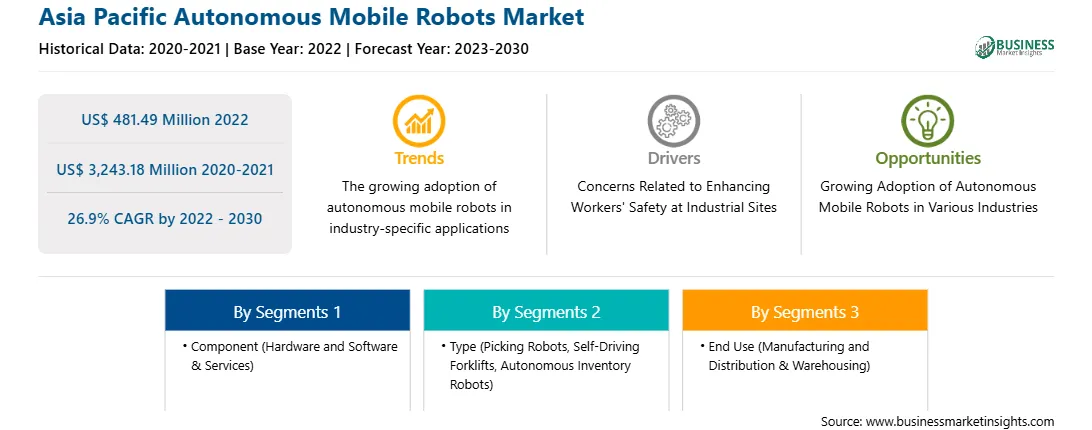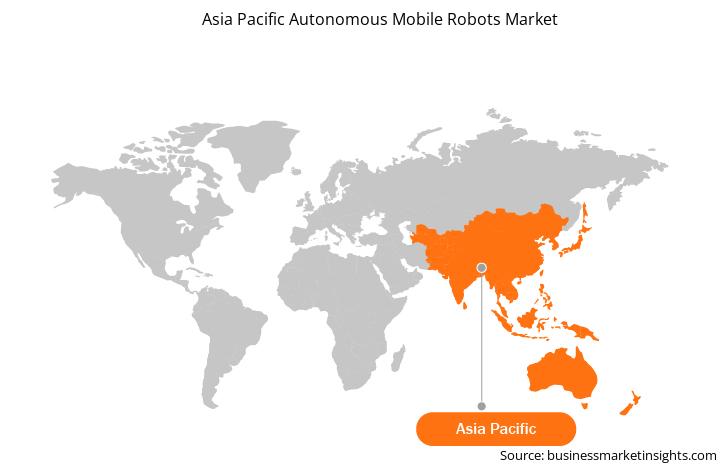Changes in the lifestyle and purchasing patterns of customers with the rise in their disposable income have been driving people’s tendency to purchasing of goods from online platforms. Online sales platforms allow customers to choose from a wide range of products, and save time and money compared to brick-and-mortar stores. The increasing penetration of the Internet and smartphones also justify customers’ preference for online shopping. According to the India Brand Equity Foundation, the number of online shoppers in India was 150 million in 2021 and is expected to reach 350 million by 2026. Further, a rise in the e-commerce industry has led to the increased transportation of goods, significantly propelling the growth of the logistics sector by boosting warehouse activities and improving supply chain operations. Many e-commerce industry players are rapidly adopting automated solutions such as autonomous mobile robots to manage the vast volumes of goods and associated information and meet customers’ expectations for faster deliveries. The adoption of AMRs helps the e-commerce industry players to deal with labor shortage issues and minimize human error. These robots can swiftly operate on damaged floors, changing surroundings, high traffic, liquid spills, slopes, narrow spaces, and elevators. According to ABB, using AMR in the e-commerce industry results in a 12% increase in delivery speed, a 26% reduction in space, and 99.9% on-time delivery. The high payload-carrying capacity of AMRs improves the operational workflow in warehouses and distribution centers, leading to its adoption in the e-commerce industry. Inventory management and picking are a few activities that AMR can efficiently manage without human intervention and error, which leads to its adoption in the e-commerce industry. With the growing adoption of AMRs, market players are increasingly introducing solutions to cater to the demands of customers from the e-commerce industry. In March 2023, OTTO Motors, a leading provider of AMR, launched OTTO 600 for material handling with the ability to move pallets, carts, and other payloads up to 600 kg (1,322 lbs). Therefore, the growing e-commerce sector encourages companies to introduce new solutions that can maximize workflow in this sector, thereby fueling the growth of the Asia Pacific autonomous mobile robots market.
The Asia Pacific autonomous mobile robots (AMR) market is further segmented into Australia, China, India, Japan, South Korea, Indonesia, Singapore, Malaysia, Thailand, and the Rest of Asia Pacific. Asia is the world’s largest market for industrial robots. The installation of industrial robots increased by 33% in 2021 compared to 2022. The adoption of industrial robots in the electronics industry rose by 22% in 2021 compared to 2020, while that in the automotive, and metals & machinery industries increased by 57% and 29%, respectively. According to the IFR, China, Japan, and South Korea are among the top five most advanced robotics countries in terms of annual installations of industrial robots as of January 2023. Governments of Asia Pacific countries are coming up with various plans and initiatives to boost the autonomous mobile robots (AMR) market. In December 2021, China unveiled a sharpened version of the Made in China 2025 industrial policy blueprint. With this, the government has released a five-year smart manufacturing development plan to digitize 70% of the country’s large enterprises. Further, through the New Robot Strategy, the Japanese government plans to make investments in the manufacturing, healthcare, infrastructure, and agriculture sectors to integrate automated solutions. Such government initiatives focused on building and owning robots, and upgrading equipment and processes would further boost the autonomous mobile robots (AMR) market in the region.
Strategic insights for the Asia Pacific Autonomous Mobile Robots provides data-driven analysis of the industry landscape, including current trends, key players, and regional nuances. These insights offer actionable recommendations, enabling readers to differentiate themselves from competitors by identifying untapped segments or developing unique value propositions. Leveraging data analytics, these insights help industry players anticipate the market shifts, whether investors, manufacturers, or other stakeholders. A future-oriented perspective is essential, helping stakeholders anticipate market shifts and position themselves for long-term success in this dynamic region. Ultimately, effective strategic insights empower readers to make informed decisions that drive profitability and achieve their business objectives within the market. The geographic scope of the Asia Pacific Autonomous Mobile Robots refers to the specific areas in which a business operates and competes. Understanding local distinctions, such as diverse consumer preferences (e.g., demand for specific plug types or battery backup durations), varying economic conditions, and regulatory environments, is crucial for tailoring strategies to specific markets. Businesses can expand their reach by identifying underserved areas or adapting their offerings to meet local demands. A clear market focus allows for more effective resource allocation, targeted marketing campaigns, and better positioning against local competitors, ultimately driving growth in those targeted areas.Asia Pacific Autonomous Mobile Robots Strategic Insights

Asia Pacific Autonomous Mobile Robots Report Scope
Report Attribute
Details
Market size in 2022
US$ 481.49 Million
Market Size by 2030
US$ 3,243.18 Million
Global CAGR (2022 - 2030)
26.9%
Historical Data
2020-2021
Forecast period
2023-2030
Segments Covered
By Component
By Type
By End Use
Regions and Countries Covered
Asia-Pacific
Market leaders and key company profiles
Asia Pacific Autonomous Mobile Robots Regional Insights

Asia Pacific Autonomous Mobile Robots Market Segmentation
The Asia Pacific autonomous mobile robots market is segmented based on component, type, end use, and country. Based on component, the Asia Pacific autonomous mobile robots market is bifurcated into hardware and software & services. The hardware navigation segment held a larger market share in 2022.
Based on type, the Asia Pacific autonomous mobile robots market is segmented into picking robots, self-driving forklifts, and autonomous inventory robots. The picking robots segment held the largest market share in 2022.
Based on end use, the Asia Pacific autonomous mobile robots market is bifurcated into manufacturing and distribution & warehousing. The manufacturing segment held a larger market share in 2022.
Based on country, the Asia Pacific autonomous mobile robots market is segmented into China, Japan, India, South Korea, Australia, Indonesia, Singapore, Malaysia, Thailand, and the Rest of Asia Pacific. China dominated the Asia Pacific autonomous mobile robots market share in 2022.
ABB Ltd; Clearpath Robotics Inc; Geekplus Technology Co Ltd; Move Robotic Sdn Bhd; OMRON Corp; and Teradyne Inc are some of the leading companies operating in the Asia Pacific autonomous mobile robots market.
The Asia Pacific Autonomous Mobile Robots Market is valued at US$ 481.49 Million in 2022, it is projected to reach US$ 3,243.18 Million by 2030.
As per our report Asia Pacific Autonomous Mobile Robots Market, the market size is valued at US$ 481.49 Million in 2022, projecting it to reach US$ 3,243.18 Million by 2030. This translates to a CAGR of approximately 26.9% during the forecast period.
The Asia Pacific Autonomous Mobile Robots Market report typically cover these key segments-
The historic period, base year, and forecast period can vary slightly depending on the specific market research report. However, for the Asia Pacific Autonomous Mobile Robots Market report:
The Asia Pacific Autonomous Mobile Robots Market is populated by several key players, each contributing to its growth and innovation. Some of the major players include:
The Asia Pacific Autonomous Mobile Robots Market report is valuable for diverse stakeholders, including:
Essentially, anyone involved in or considering involvement in the Asia Pacific Autonomous Mobile Robots Market value chain can benefit from the information contained in a comprehensive market report.